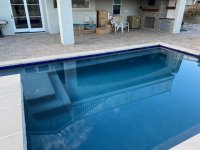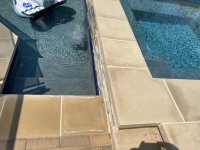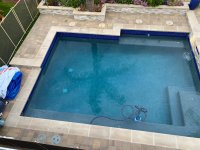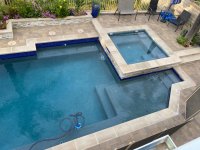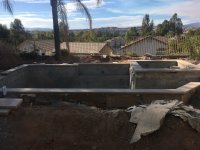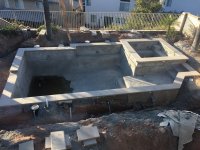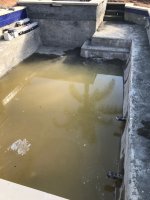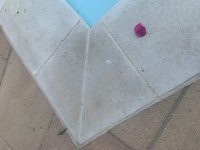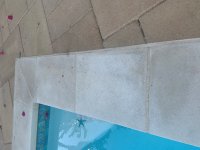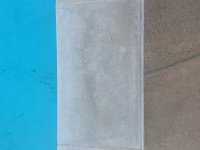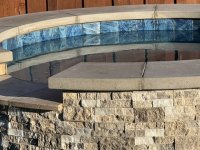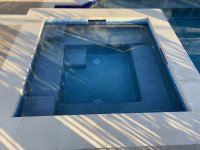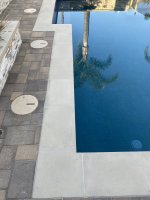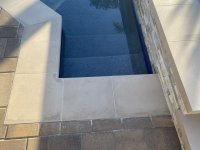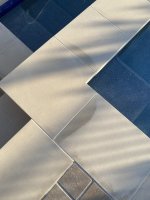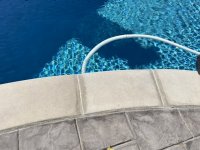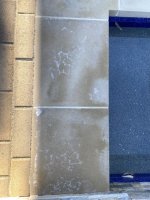Hi,
I have a recently built inground gunite swimming pool with attached spa. Gunite installed in July 2020. A couple weeks later, Bellecrete cast concrete coping was installed on top of the bond beam. Construction stopped at that point and the gunite shell with coping sat dry for almost a year. During this year, the coping looked brand new, just as good as it was the day it was installed. Stonescapes mini pebble was installed May 2021 (almost a year later). Coping still looked good. Pool was filled immediately after, also May 2021. Soon after filling the pool, we noticed a few perpetually wet spots on the coping. Soon the spots got worse and all the coping was discoloring. Moisture discoloration and efflorescence got worse and worse. A couple of months later (Aug 2021) Pool builder called out the coping manufacturer, Bellecrete, and they suggested acid wash. That was performed but no difference. Pool builder is now proposing to rip out and replace all coping.
Some facts:
My home and yard is on a hill with a downward grade behind the pool.
We are in Southern California desert where it has been 100+ degrees for many days and we still see the same moisture stains.
There are no sprinklers anywhere (we have hardscape and artificial turf). Drip system for planters was installed after this problem appeared.
The Angelus pavers that are placed right next to the coping doesn't seem to be showing any moisture issues.
Coping was installed on top of bond beam with some sort of mortar... didn't look like anything special.
Our waterline tile is 6" square with grout. The grout seems like normal grout (not necessarily pool-specific?)
The waterline tile-to-coping transition is caulk inside the spa and grout in the pool.
The 2 spillways from spa to pool are openings covered on top by coping and the very middle of each of those pieces of coping appears to be dry.
The corner of the spa has coping with moisture staining and it isn't adjacent to any ground for ground moisture to affect it.
The steps are made from the same coping. The steps show a TINY bit of moisture marking, but nowhere near like the rest of the pool.
I understand the pool coping closest to the spa could get moisture from the spillways dribbling along the stone face. This explains some moisture immediately near the edge of the spa/pool transition, but not the entire pool.
The pool has not been overfilled (2/3 up the skimmer, right in the middle of the waterline tile)
The pool has an auto-fill that keeps the water level at the same proper level
If ground moisture was the issue, wouldn't I see issues with my pavers too? The sanded joints don't seem wet, there's no discoloration or efflorescence even on the adjacent pavers.
1) Is this normal for cast concrete coping? My PB thinks it is not.
2) Where is the moisture coming from?
3) Should I be concerned that moisture will return in any new installation?
4) Should I replace with different coping/material to hide the issue?
My theories:
a) The gunite / bond beam is saturated. Is that a thing? Should the top of the bond beam be waterproofed before setting coping?
b) The waterline tile grout lines are wicking water up to the coping. This seems possible because the very first small moisture spots we saw were at the top of grout lines. This might explain the pool waterline with straight 6" tiles, but the spa tile is glass tile hexagons with caulk at the top. Does it matter? Is this a thing? How is it resolved?
c) There's a leak somewhere (maybe the autofill? somewhere else?). My water bill has been slightly higher, I assume because of evaporation but it doesn't seem like I'm losing a TON of water with the autofill turned off or paying a LOT more for water.
Please help! I'd hate to have PB replace coping and end up in the same spot.
Attached pics:
1) first sign of moisture after filling pool
2) close up of moisture staining on coping
3) overhead view today
4) overhead view today
I have a recently built inground gunite swimming pool with attached spa. Gunite installed in July 2020. A couple weeks later, Bellecrete cast concrete coping was installed on top of the bond beam. Construction stopped at that point and the gunite shell with coping sat dry for almost a year. During this year, the coping looked brand new, just as good as it was the day it was installed. Stonescapes mini pebble was installed May 2021 (almost a year later). Coping still looked good. Pool was filled immediately after, also May 2021. Soon after filling the pool, we noticed a few perpetually wet spots on the coping. Soon the spots got worse and all the coping was discoloring. Moisture discoloration and efflorescence got worse and worse. A couple of months later (Aug 2021) Pool builder called out the coping manufacturer, Bellecrete, and they suggested acid wash. That was performed but no difference. Pool builder is now proposing to rip out and replace all coping.
Some facts:
My home and yard is on a hill with a downward grade behind the pool.
We are in Southern California desert where it has been 100+ degrees for many days and we still see the same moisture stains.
There are no sprinklers anywhere (we have hardscape and artificial turf). Drip system for planters was installed after this problem appeared.
The Angelus pavers that are placed right next to the coping doesn't seem to be showing any moisture issues.
Coping was installed on top of bond beam with some sort of mortar... didn't look like anything special.
Our waterline tile is 6" square with grout. The grout seems like normal grout (not necessarily pool-specific?)
The waterline tile-to-coping transition is caulk inside the spa and grout in the pool.
The 2 spillways from spa to pool are openings covered on top by coping and the very middle of each of those pieces of coping appears to be dry.
The corner of the spa has coping with moisture staining and it isn't adjacent to any ground for ground moisture to affect it.
The steps are made from the same coping. The steps show a TINY bit of moisture marking, but nowhere near like the rest of the pool.
I understand the pool coping closest to the spa could get moisture from the spillways dribbling along the stone face. This explains some moisture immediately near the edge of the spa/pool transition, but not the entire pool.
The pool has not been overfilled (2/3 up the skimmer, right in the middle of the waterline tile)
The pool has an auto-fill that keeps the water level at the same proper level
If ground moisture was the issue, wouldn't I see issues with my pavers too? The sanded joints don't seem wet, there's no discoloration or efflorescence even on the adjacent pavers.
1) Is this normal for cast concrete coping? My PB thinks it is not.
2) Where is the moisture coming from?
3) Should I be concerned that moisture will return in any new installation?
4) Should I replace with different coping/material to hide the issue?
My theories:
a) The gunite / bond beam is saturated. Is that a thing? Should the top of the bond beam be waterproofed before setting coping?
b) The waterline tile grout lines are wicking water up to the coping. This seems possible because the very first small moisture spots we saw were at the top of grout lines. This might explain the pool waterline with straight 6" tiles, but the spa tile is glass tile hexagons with caulk at the top. Does it matter? Is this a thing? How is it resolved?
c) There's a leak somewhere (maybe the autofill? somewhere else?). My water bill has been slightly higher, I assume because of evaporation but it doesn't seem like I'm losing a TON of water with the autofill turned off or paying a LOT more for water.
Please help! I'd hate to have PB replace coping and end up in the same spot.
Attached pics:
1) first sign of moisture after filling pool
2) close up of moisture staining on coping
3) overhead view today
4) overhead view today


